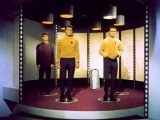Teleportation defines the relocation of exactly the same item from one initial place to another by using specific technology or paranormal methods. The first mention of the word was in Charles Fort's book “Lo!” from 1931, referring to the connection between the strange occurrence and evanescence of certain anomalies. In his own words, “Mostly in this book I shall specialize upon indications that there exists a transportory force that I shall call Teleportation”. The term derives from the Greek prefix “tele-”, meaning “distant” and the Latin “portare”, “to carry”.
There are many unofficial cases of teleportation which fuel people's imagination and conspiracy theories, like the Philadelphia experiment, strongly-denied by its supposed authors, the US Navy, or that of a Filipino guardia civil of the Spanish era who disappeared all of a sudden from his location at the palace of the governor general in order to appear at the same time on the other side of the planet, in Mexico City, without him knowing what had happened.
There are many hypothetical ways in which the teleportation process can take place. The most commonly discussed is the technological transmission of information which serves to recompose a certain item or organism on a specific destination. A second one implies that a subject exits a physical universe only to re-enter it in another location. A variation of this theory involves traveling at a super-light speed using a wormhole (space-time shortcuts) and avoiding the complications posed by signal interference or by the uncertainty principle and exiting almost simultaneously at a different place. Both versions, called “Displacement”, are regarded as only fictional, since no essential data has been discovered in relation to any of the elements involved in the process. Teleportation is also speculated to be possible through the means of mind or abnormal individual abilities, but although this form, which is referred to as “psychoportation”, or “jaunting,” may theoretically surpass any scientific, ethical or religious obstacle met by the previous ones, it is given the cold shoulder and regarded as the least probable. Assuming that not many of our readers have such innate capabilities or undergo intensive mind trainings in order to achieve this otherwise scientifically (still) impossible feat, for the sake of the article we will only address the first approach, the technological one.
Besides the obvious, scientific aspects, this phenomenon has other implications, such as the religious or philosophical ones. First, let's see what all the fuss about this phenomenon is. It's easy to imagine that, since the earliest humans began traveling for greater distances, the first complaints about time and energy consumption arose. With the revolution caused by the invention of the wheel and the observations on bird flight, all got somehow simpler at some point. But it is in human nature not to be content with what one has, and always yearn for bigger, better, faster, more. Speaking of faster, it turns out that nowadays not even the top cars or airplanes are enough in order to satisfy the needs of busy people. Not to mention that I, myself, also hate that fat guy type that keeps sticking his sweaty odor directly in my nose every time I use public transportation. Naturally, the next giant leap for humankind that comes to mind is instant traveling. But what if I were to tell you that, while an exact copy of yourself (all abilities and traits included in the package) would indeed reach the desired destination, you, the original, would be destroyed in the process? At least, that's how far science has got up to now.
If you were hoping to find out about a major breakthrough on human teleportation (or, at least, of a small, tiny animal – come on, at least a bacteria!), now it's high time you're disappointed. There has been none so far and there won't be any for quite some time – at least none that we know of. The only thing that scientists were able to relocate on instant basis were atoms and photons (quantum teleportation), the light particles, which could only prove useful for supercomputers and unbreakable security, at best, since they ensure the transmission of massive amounts of data at the speed of light. Australian, Austrian and Danish teams, all working independently of each other, obtained the same results by different means. Neat, but rudimentary – not what we were hoping.
Since the discovery of IBM's Charles H. Bennett and his team in 1993, it has been repeatedly proven (also by the three aforementioned teams) that, in order for the teleportation process to be successful, the original item must be destroyed. As Bennett would have it, “This whole area is surrounded by a sort of mystique that makes people feel they can't understand it”. And he would be right in a way, if thought that teleportation as a theoretical phenomenon was considered to break the laws of physics, mainly the Einstein-Podolsky-Rosen Effect (or the EPR Paradox, which refers to the relation between the known physical quantities values and the values which a physical theory can account for) and The Heisenberg Uncertainty Principle. The latter states that one cannot exactly measure any object, since by doing so one alters the very structure of the observed object, culminating with the total disruption of the initial item before being able to collect enough data in order to replicate it perfectly.
But this is exactly what teleportation intends to do. Luckily, Bennett comes to shed some more light on the topic, “This whole area is surrounded by a sort of mystique that makes people feel they can't understand it. In fact it is simpler than it sounds. What you have to note is that in this sort of experiment the atom itself is not teleported, but rather the delicate quantum information contained in the atom. In effect you are disembodying the complete quantum state of one atom and reincarnating it in another atom of the same sort”. As quoted by the CNN, Valerie Jamieson, a New Scientist Magazine physics editor enhances the details for an easier comprehension, “This is not teleportation as we like to think of it, namely an object disappearing from one place and reappearing in another. Rather, it is about the transferring across space of the quantum properties of particles, and in particular their spin. One way of imagining it is to think of a snooker table with balls on it. In the traditional view of teleportation a spinning ball will de-materialize at one end of the table and exactly the same ball will re-materialize at the other end. In quantum teleportation the spinning ball stays where it is, but its spin is transferred to another ball somewhere else on the table, in effect creating a Doppelgänger. It is an aspect or a 'property' of the original ball that has been transmitted rather than the ball itself. Although to complicate matters the process of transmission would destroy the original ball”. The Doppelgänger originally designated a “ghostly” double of a living being, but can be metaphorically extended to inanimate objects.
The quantum teleportation is actually based on (yet another ambiguous term) quantum entanglement, which causes two different particles separated by distance to behave similarly at the same time, any of them reflecting the changes made on the other. The Austrians, for example, supercooled atoms to a temperature of nearly 0 degree Kelvin (-273 degree Celsius or -459.67 degree Fahrenheit), actually only a billionth of a degree above absolute zero. A weird physical property causes that all atoms behave absolutely identically at that specific temperature, which is exactly the point when the Austrian researchers subjected them to the light of two lasers. Physicist Murray Olsen from the Australian Research Council Center for Quantum-Atom Optics, one of the scientists involved in the study, is more specific, “If you cool these atoms down enough ... in a condensate, they all enter the same quantum state”.
“When a few thousand atoms are overlapping (and you hit them with the laser beam)... they basically disappear. We can use an optic fiber (to transport the signal at the speed of light) into a second condensate, which could be in another room, or another building, or another state. We’ve got the coldest thing in the universe and the fastest speed in the universe.” Although he and his colleagues were able to accomplish this feat, he is highly skeptical towards ever getting to see humans beings teleported.
Relying on the quantum entanglement technique, experts managed to transfer the properties of a specific particle to some other one, placed half a meter (in atoms' case) or tens of km (for photons) away. This drives Bennett to assume that human teleportation could theoretically be feasible for humans too, even without making use of the quantum entanglement's complications. As he says, “Quantum entanglement is valuable in transmitting particles such as atoms and photons where the most delicate properties are significant and where simple approximation is not enough. Teleporting a person, on the other hand, would not require reproducing the quantum state anything like as exactly. Everything we know about biology and how molecules fit together to produce a living being, including the brain, indicates that creating some level of approximation would give you a real person who was a serviceable replica of the original in terms of looking the same and thinking the same thoughts, without necessarily being a perfect quantum replica. The teleported person would end up slightly different, but not in a biologically important way. It's the same principle as a fax machine: when you fax something what comes out the other end obviously looks like the original and contains the same information. It's not the same paper, however, or the same type of ink”.
The immediate technological implication of this aspect is that the process would require a highly advanced scanning device, one that could accurately extract all the needed information from the entirety of the human body, which is not small – about 1028 atoms. Such technological feat is not in sight yet.
As previously mentioned, the other implications of this endeavor would make materialistic philosophers and clergymen extremely anxious, to say the least. This involves issues like the continuity of existence after the original human is “canceled” in favor of a new copy, namely, would this copy be able to continue the thoughts, actions, behavior or aspirations of the initial person? And then again, what happens to the soul of the original and, even more, where does the soul of the copy come from? Doesn't the destruction of the original present all the premises of murder? And what about recreating more than just one copy at a time? All these questions, as well as many others (of which many remind me of a similar issue involving human cloning, but which I will not continue to share, since this would result in too long of an article) need to be addressed way before the teleportation perspective gets a grip on reality. In the meantime, you're free to ponder on them, or expect for alternative solutions for a safer teleportation method (if you think of any, feel free to post a comment).
But don't worry just yet. As Bennett claims, “If you consider all the atoms in a person, and the fact that in the scan you would have to locate all those atoms to within a nanometer of each other, and then have some machine capable of translating that information into DNA, water, fat, protein etc. – it's just silly to think about”. Jamieson seems to borrow the IBM specialist's enthusiasm concerning the possibility of teleportation, “I really don't think it is ever going to happen. Then again, one thing I've learned is never to underestimate the ingenuity of physicists, so never say never”.

 14 DAY TRIAL //
14 DAY TRIAL // 

